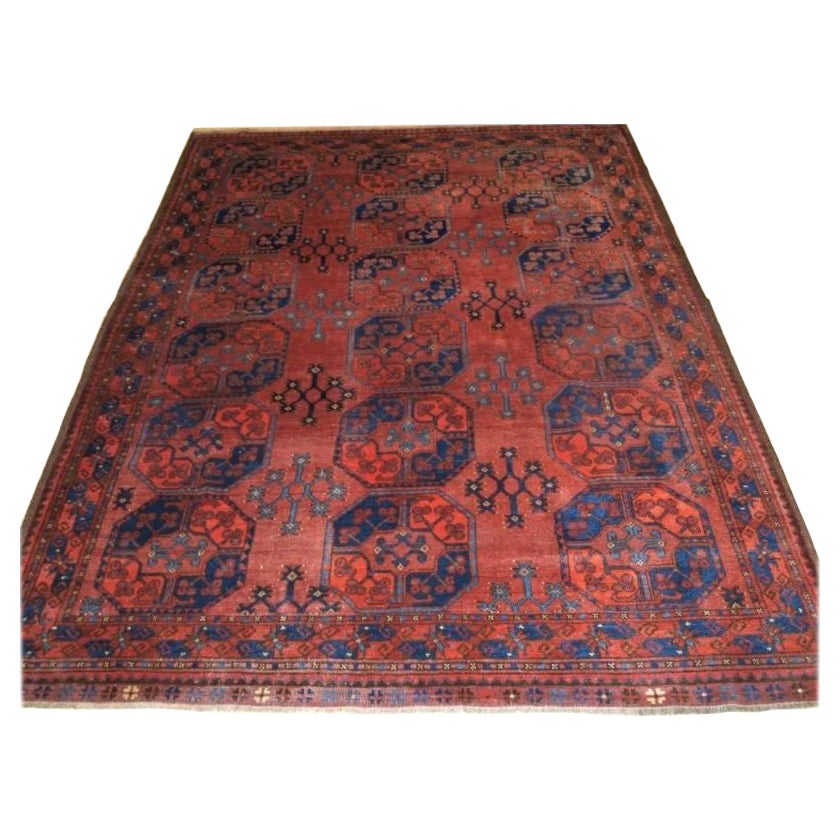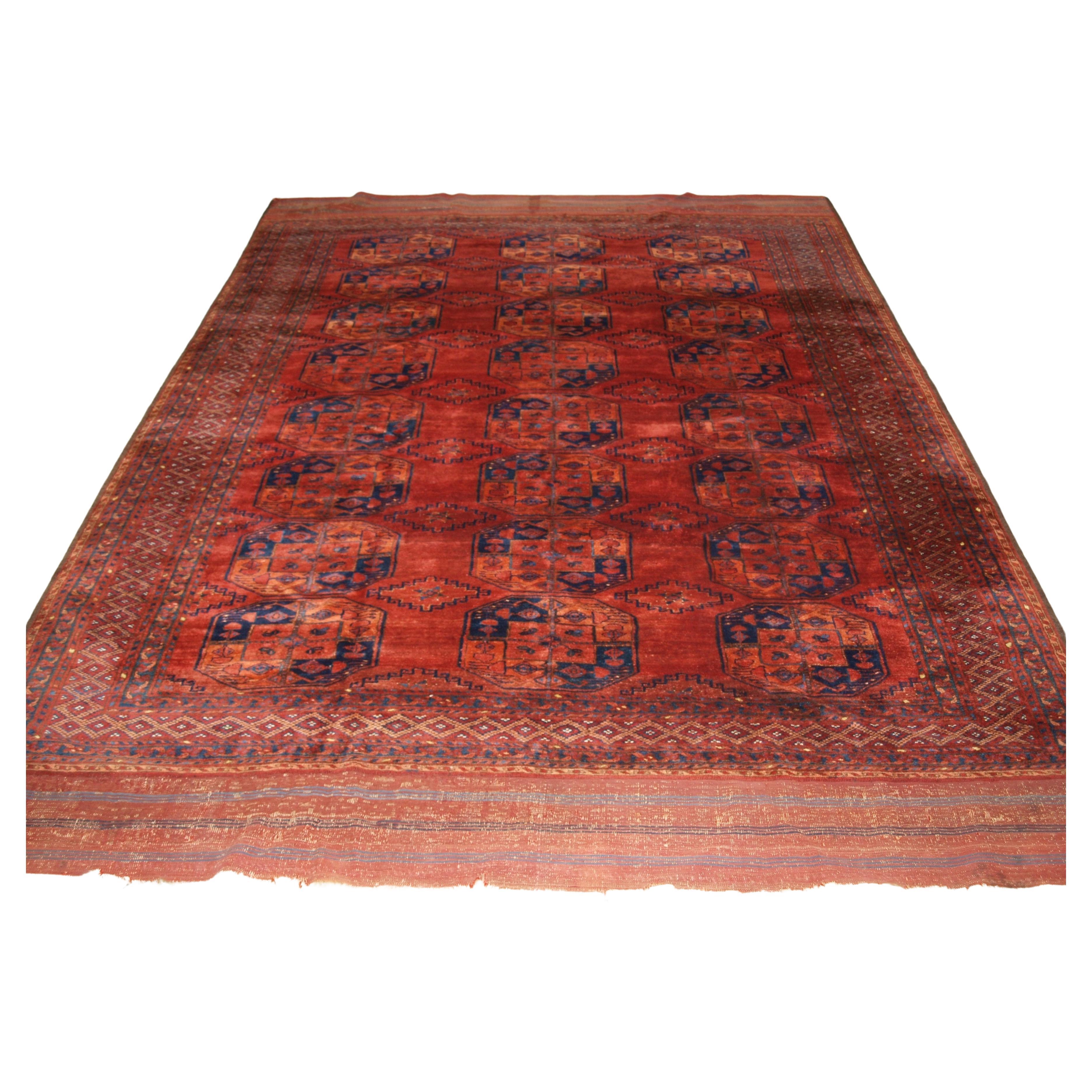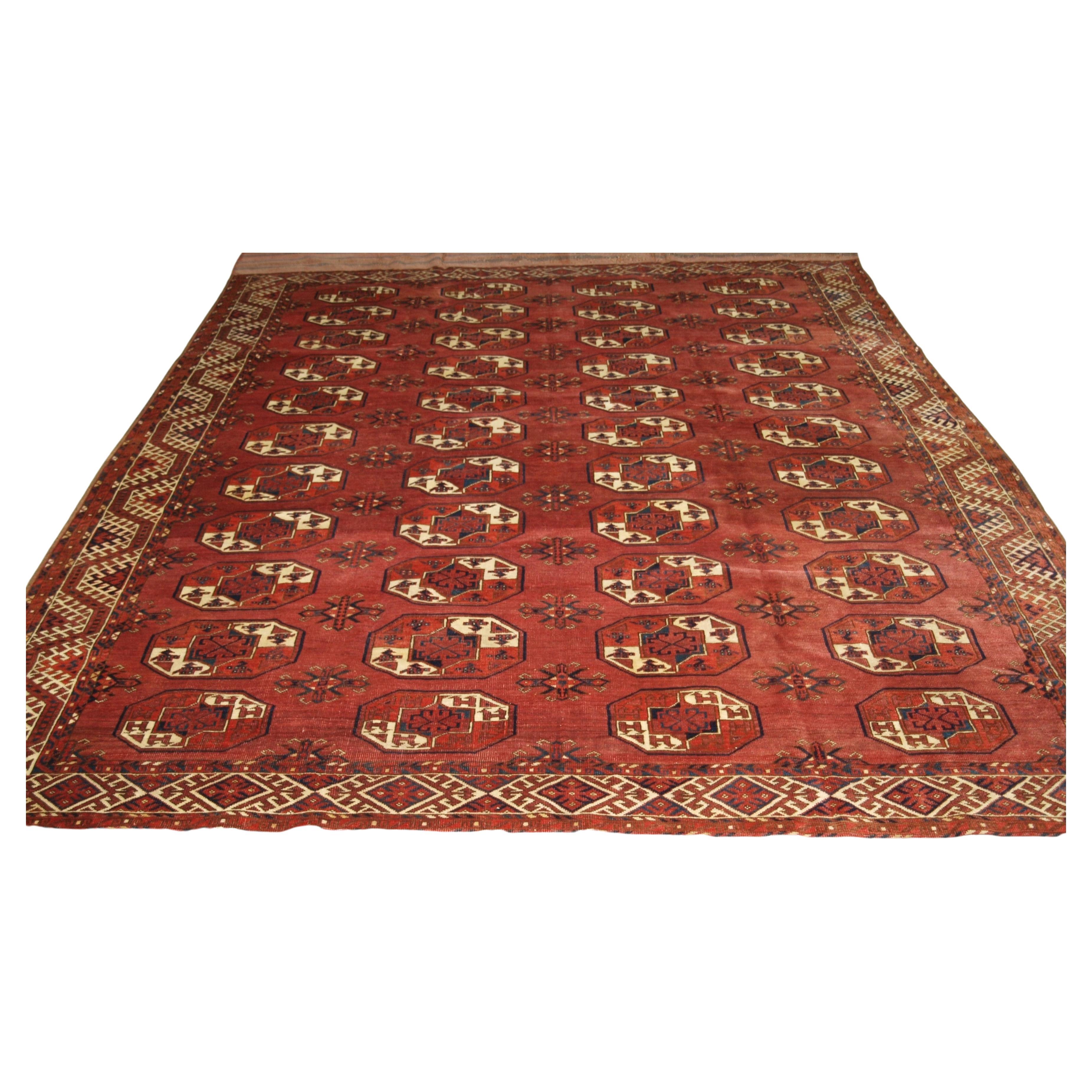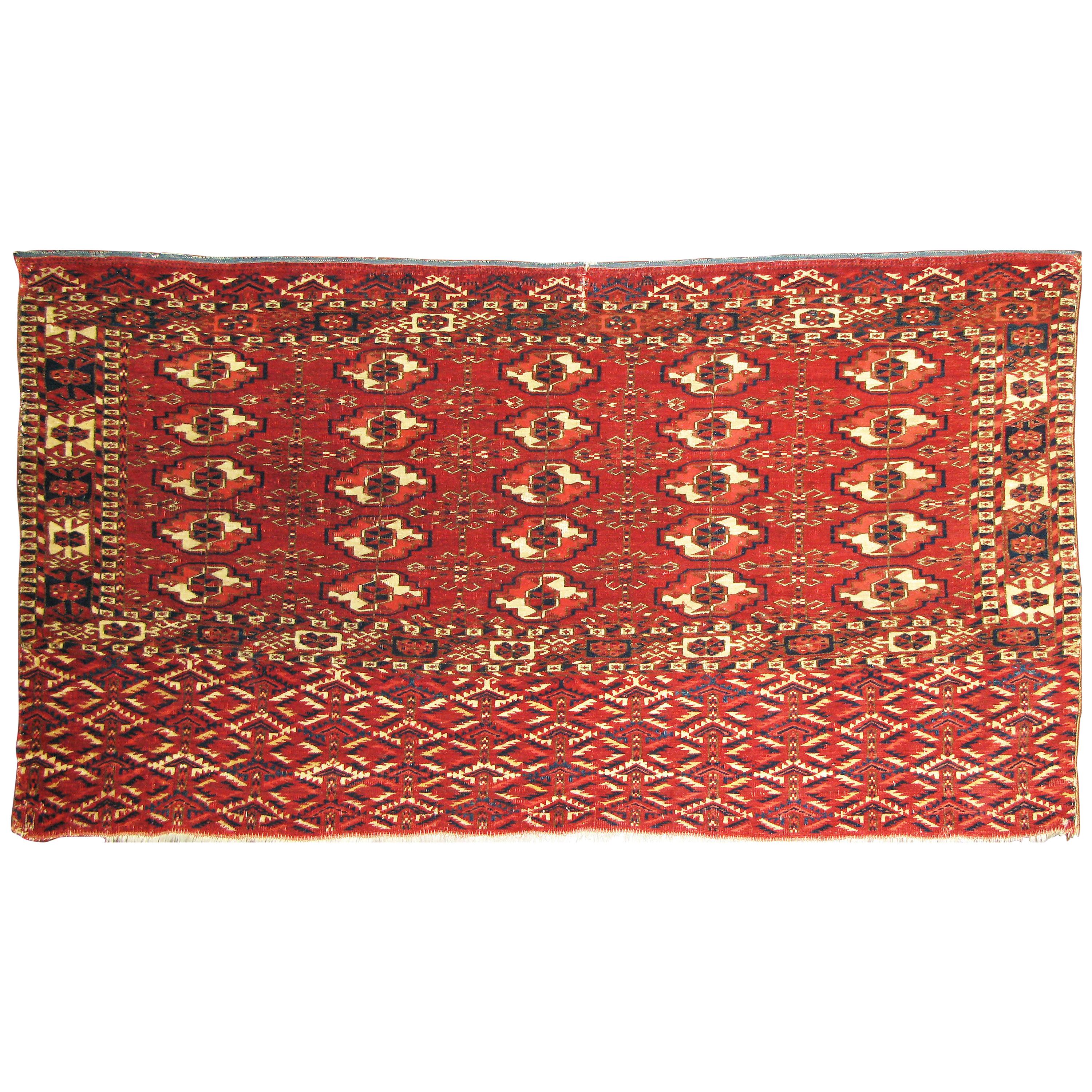Items Similar to Ersari Turkomen Very Rare small main carpet circa 1860 short term reduction
Want more images or videos?
Request additional images or videos from the seller
Ersari Turkomen Very Rare small main carpet circa 1860 short term reduction
About the Item
Acquired from a Viennese collector’s estate
The Ersari tribe of the wider Turkomen nation living in Turkmenistan, Afghanistan and Iran are one of the weaving tribes better known and understood by scholars. The Tekke Turkomen’s woven materials are perhaps best known in the West, followed by the Yomud, Salor and Ersaris. A Salor main carpet, 30% larger and about 40 years older than this piece recently sold in Austria for over $50,000, such is the scholarly , collection, and investment zeal found around the world . We are making this piece available at a short term steep discount to conincide with out launch on 1st Dibs .
These and other kindred tribes produce rugs, bags, Amalysks (bridal bags) and Engsis (Tent doors in woven wool) all of which are sought after by collectors. Though the use of the Gul or oval motif is consistent throughout and a cousinage can be easily identified, each tribe uses somewhat different pattern language and symbolism; slight variations in colour use and arrangement become evident upon viewing many pieces and with supplementary reading.
This 160-year-old piece is distinctive indeed for its unusual use of yellow. Otherwise it is a premium condition and rare rug, designed for use in the yurt as the main carpet, (common terminology).
Given its premium quality wool and very fine condition, it is a rug ideal for medium wear use which will last indefinitely with modest care. It has a powerful tribal “personality “which enrich any number of rooms in the home.
Above all, it is a tribal artefact of a bygone nomadic era, esthetically exciting and evocative. This is a particularly pleasing rendition of traditional design elements. Though Ersari rugs are woven according to tribal conventions, each piece holds its own differences, created by the female weaver. This is a very fine example. And clearly an excellent fine art investment .
Fine Art as an investment ? The WSJ had this observation to make ( which we have observed for over 50 years ) :
Art has become established as an accepted ,indeed prudent element of personal investment portfolios: According to Deloitte’s 2021 Art and Finance Report, “In 2014, only 53% of wealth managers believed art should be included as part of a wealth management service… with 85% of wealth managers saying so in 2021.” Citigroup’s Global Art Market reports contemporary artwork outperforming the S&P by 174%.
- Dimensions:Width: 67 in (170.18 cm)Length: 87 in (220.98 cm)
- Materials and Techniques:Wool,Woven
- Place of Origin:
- Period:
- Date of Manufacture:1860
- Condition:Beautiful wool, in excellent condition .
- Seller Location:WYNNUM, AU
- Reference Number:
About the Seller
No Reviews Yet
Vetted Seller
These experienced sellers undergo a comprehensive evaluation by our team of in-house experts.
1stDibs seller since 2022
- ShippingRetrieving quote...Ships From: WYNNUM, Australia
- Return PolicyA return for this item may be initiated within 3 days of delivery.
More From This SellerView All
- Aristocratic Ferahan Sarouk 1890 Antique Short Term ReductionLocated in WYNNUM, QLDARISTOCRATIC Ferahan Sarouk 1890 Measures: 6 ft 8 inches x 4 foot 4 inches Ladies, if you seek a gift for your much loved man, to make him feel like...Category
Antique 1890s Persian Persian Rugs
MaterialsWool
- Extremely Rare Antique Large Tekke TurkomenLocated in WYNNUM, QLDTurkomen carpets of this size and quality have been continually in demand but very difficult to acquire. Verified as to age, it appears to have been woven for a chieftan or tribal leader as it would require a large yurt to accommodate it , and its date of origin is earlier than the period wherein significant, if any ,importation of Turkomen carpets to the West occurred. The wool (warp and weft) of this carpet is of superior and lanolin rich quality with a beautiful soft feel and pile in excellent condition. The richness of the colours—triple dipped in the dye vat...Category
Antique 19th Century Uzbek Central Asian Rugs
MaterialsWool
- High Collectible 19th Century Ferahan Sarouk, Princely, at Short Term ReductionLocated in WYNNUM, QLDFerahan Sarouk Museum Quality MUSEUM QUALITY Ferahan Sarouk, third quarter 19th century 6.6 x 4.5 feet From a USA collector Ferahan Sarouk carpets produced around the wider Arak (formerly Sultanabad) area from about 1850-1910 earned a deserved reputation as amongst the most desirable and imaginative finely woven carpets in Persia. As these things go, they morphed in style around 1910- 1920 into the differently woven Mahajirhan Sarouk fashion (quality examples of which are also in demand) and then disappeared entirely. Their desirability rests not only on fine weaving, and excellent wool. Many of the better examples were commissioned by aristocrats or wealthy merchants who encouraged creativity, in an actively competitive way; rugs during this period, as before, were direct illustrations of an individual’s wealth, power and prestige. Beyond this lay a more fundamental and seemingly contradictory set of motivations by the weavers. At one and the same time they sought to emulate the great court carpets in finesse and design. And yet-- they applied rustic or village, and even tribal elements and nuances to their designs. The result was a cavalcade of creativity. So, a village-based genre came into being which produced primarily an approx. 6x4 rug size format, and also provided, if more rarely, larger formats, which command increasingly high prices, due to their rarity, visual excitement and grandeur. The artistic achievement of this “school” had to do with marrying elegance and a degree of formalism with whimsy, and design innovation. They offer a charm and a certain magic beyond that of court and most city carpets. As in any area or era, there is a quality spectrum ranging from mediocre to highly superior. Superiority is judged of course as to weave and wool quality. It is rather unusual, though, to encounter pieces made before 1890 -which are bona fide Ferahan Sarouks- with poor wool or weaving: standards were upheld during this period, and natural dyes were widely employed, particularly in the wider Arak (then Sultanabad) region. Thus, as an investment collectible to adorn the home we believe the ultimate criterion is aesthetics, this being an art form, after all. Ferahan Sarouks have been a special area of interest for us over the decades both from artistic and investment perspectives. Allowing for personal taste, our suggestions are few and simple. A Ferahan Sarouk ought to display a wide colour palette, fine drawing and delicate, sometimes “intense “ detail. The finest pieces also display an elevated sense of balance in the use of space. We have seen many finely woven pieces which in our view are garish and lack one of the two key artistic elements intrinsic to the better examples of this genre – elegance. Sometimes they are overly cluttered; the drawing artistry is muddled or lost. In other cases odd and ineffective design devices are used, detracting from or interfering with an otherwise good design. The era of the Ferahan Sarouk was rife with experiments, not all of them successful. The other important attribute, when it can be found, is original artistic creativity, even serendipity, -- or effective design innovation within the compass of this rug type and the unique standards of its prime period. On average, we examine between 30-40 antique Ferahan Sarouks to achieve one acquisition, for the benefit of our clients. This highly collectible more than 150-year-old carpet is an apex achievement of superior artistry and innovation. As an exemplar of its genre, it can be reasonably described as Museum quality, a term we do not often employ. Please observe the stunning precision of the inner guard and its pinpoint sharp hooks. The elongation of the central medallion is one of its subtle but powerful innovations in form. The nod to asymmetry – which displays a refined sense of humour - is seen in the use of the small diamond figures, as one is deliberately missing from the right hand side: a wry nod to asymmetry, in an otherwise perfectly symmetrical creation. The ultimate achievement here is in the fineness of the weaving itself, on close inspection. The herati pattern in the medallion and corners achieves an etched-on quality, a very uncommon level of attention to detail and perfectionism: clearly the work of a master. This artistic sense extends to the outer ground which is a superb example of the most subtle abrash, one of the most refined we have had the honor of viewing. The unusual beige/brown tones in the field were probably achieved by adding onion skins to the die vat. These extremely fine gradations of colour are rarely seen.(NB the colour photographs create a slightly misleading- overly yellow burnish to the field colour in spite of expert photographic efforts ) . The deliberate choice of an ink black use of indigo provides a powerful frame (border) for this piece of art, which note in the lower right-hand corner is lifted slightly through abrash to a deep blue – to highlight the design and use of emerald green in the rosettes. The green shades lighten as the border ascends harmonizing with the tones in the central medallion. The floating flow of flowers in the border is beautifully executed, with up to seven colours in a single figure. No doubt a piece commissioned by an aristocrat around 1870, it is – remarkably- in virtually perfect condition. It appears to have had very minimal footwear, and great care; a piece which was proudly displayed from time to time and appreciated. Its density and strong foundation would however allow regular use within a home, and in a spacious contemporary home or office could make a wall hanging of striking impact. This remarkable one of a kind piece is on short term reduction to coincide with our launch on 1st Dibs . Fair market value is approximately $22,000 . Fine art as investment ? The WSJ made the following comments this year : The vigor of the art market may seem counterintuitive, but it makes sense in the current environment,” economist Tyler Cowen recently wrote in The Washington Post. “First, many of the wealthy have been buying additional homes and wish to furnish them with art. Second, the recent run-up in inflation rates around the world has intensified the search for hedges.” While the aforementioned artworks fall into traditional categories, some less-prominent forms of fine art also represent ideal investment opportunities, especially because they offer more attractive—i.e., significantly less costly—entry points for new collectors. Take high-collectible and connoisseur-caliber antique Oriental rugs, for example. The best 19th-century examples often sell privately between five figures and low six figures. Today, that obscurity is fading. According to Ben Evans, the editor of Hali Magazine—a publication dedicated to the international rug and textile market—there are two primary factors to explain why antique rugs are beginning to enjoy their moment in the spotlight. “Cultural curiosity and collecting...Category
Antique 1880s Persian Persian Rugs
MaterialsWool
- Hard to Find Rich oversize TABRIZ PRAYER RUG ANTIQUE , SHORT TERM REDUCTIONLocated in WYNNUM, QLDTabriz Prayer Rug circa 1900 4.1 feet x 5.8 Acquired from an Istanbul dealer A strange mystery exists. Why are the vast majority of prayer rug...Category
Antique Early 19th Century Persian Persian Rugs
MaterialsWool
- Large Antique Turkomen Saddle Bags (Pair)Located in WYNNUM, QLDThese hard-to-find large saddle bags, which were used by Salor Turkomen nomadic tribes can serve as stuffed and comfortable cushions, to form a bottom and back unit, or are entirely ...Category
Antique Late 19th Century Turkish Turkish Rugs
MaterialsWool
- Masculine "mystery" S.Azerbaijan grand format carpet -Antique, 1860 or earlierLocated in WYNNUM, QLDSouthern Azerbijan – A TRUE MYSTERY CARPET 2nd half 19th century, or earlier 10 x 6 From a Colorado Collector’s estate This carpet has proven to be a ...Category
Antique Mid-19th Century Azerbaijani Caucasian Rugs
MaterialsWool
You May Also Like
- Antique Ersari Turkmen Main Carpet of Small Size, circa 1880Located in Moreton-In-Marsh, GBThis fine carpet has three rows of six large guls with a linked star shaped minor gul. Note the single row of floral rosettes at each end outside the border, this is quite unusual. T...Category
Antique 19th Century Turkmen Central Asian Rugs
- Antique Afghan Ersari Turkmen Main CarpetLocated in Moreton-In-Marsh, GBAn antique Ersari Turkmen main carpet from Northern Afghanistan. This fine carpet has three rows of eight large guls with a diamond shaped minor gu...Category
Antique 19th Century Afghan Georgian Central Asian Rugs
MaterialsWool
- Ersari Main Carpet, 19th centuryLocated in San Francisco, CAErsari Main Carpet, 19th century Additional Information: Dimensions: 7'8" W x 9'10" LCategory
Antique 19th Century Asian Central Asian Rugs
MaterialsWool
- Red Antique Kizyl Ayak Ersari Turkmen Main CarpetLocated in Moreton-In-Marsh, GBAn antique Kizyl Ayak Ersari Turkmen main carpet with the ‘tauk nuska’ ’ gul design; each segment of the gul contains two double headed birds. The carpet has a soft red ground colour...Category
Antique 19th Century Turkmen Georgian Central Asian Rugs
MaterialsWool
- Antique Ersari Main Rug - 19th Century Turkmen Ersari Main Rug, Antique RugLocated in Sultanahmet, 3419th Century Turkmen Ersari Main Rug Size 225 x 280 cm (7,38 - 9,18 ft) It is a hand-knotted tribal carpet made entirely of natural dyes and hand-woven wool. This rug was woven as p...Category
Antique 19th Century Turkmen Central Asian Rugs
MaterialsWool
- Very Fine Antique Tekke Turkomen Rug, circa1900Located in Evanston, ILThe Tekke are a nomadic group from central Asia north western Afghanistan and constantly at war in struggle for water and grazing for their herds. The rug is showing a far greater d...Category
Antique Late 19th Century Central Asian Tribal Central Asian Rugs
MaterialsWool





